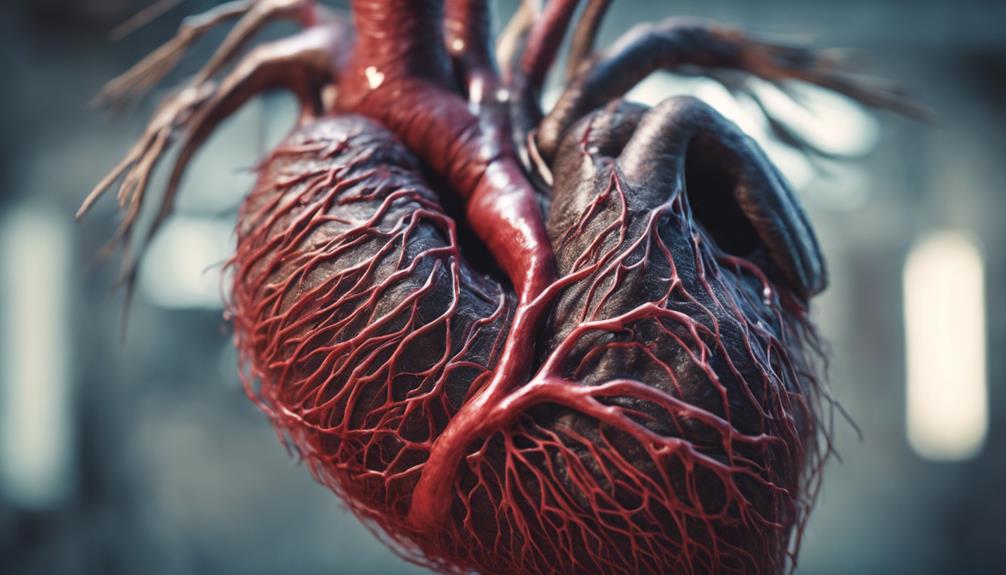
Did you know that emus are the second-largest living birds in the world, standing tall after ostriches?
Their unique physiology is a fascinating subject that sheds light on the remarkable adaptations these flightless birds have developed over time.
From their skeletal structure that supports their large bodies to the intricate workings of their cardiovascular system, each aspect of an emu's anatomy offers a glimpse into the evolutionary journey that has shaped these remarkable creatures.
Stay tuned to uncover the secrets behind their muscular system, digestive intricacies, and so much more.
Key Takeaways
- Emus exhibit remarkable joint flexibility and optimal bone density for agile locomotion.
- Their cardiovascular system supports endurance and rapid adjustments in heart rate.
- Emus possess specialized digestive adaptations for efficient nutrient processing.
- Sensory perception, including visual acuity and olfactory discrimination, aids in survival and navigation.
Skeletal Structure

When examining the skeletal structure of emus, it's essential to understand the unique adaptations that enable these flightless birds to move with efficiency and agility. Emus possess remarkable joint flexibility, allowing for a wide range of motion crucial for their dynamic locomotion. This flexibility, coupled with their optimal bone density, supports the emus' ability to navigate diverse terrains with ease.
The limb proportions of emus play a pivotal role in their locomotion techniques. Their long, slender legs provide leverage and stability, aiding in their swift movements. The arrangement of bones in their limbs is finely tuned to distribute weight effectively, enhancing their balance during running and other activities.
Emus' skeletal structure is a testament to the intricate design honed through evolution to suit their terrestrial lifestyle. By studying the joint flexibility, bone density, limb proportions, and locomotion techniques of emus, we gain insight into the biomechanical marvel that allows these birds to traverse their environment with grace and efficiency.
Muscular System
Emus' remarkable skeletal adaptations directly influence the functionality and efficiency of their muscular system in facilitating their dynamic locomotion and agile movements across diverse terrains. The muscular system of emus plays a crucial role in their ability to run at high speeds and navigate challenging environments efficiently. Understanding their muscle function and energy efficiency sheds light on the impressive capabilities of these flightless birds.
When delving into the muscular system of emus, it's essential to consider the different muscle fiber types that contribute to their unique locomotion patterns. Emus possess a combination of fast-twitch and slow-twitch muscle fibers, allowing them to sustain prolonged periods of running while also achieving bursts of speed when needed. This balance of muscle fiber types enables emus to move swiftly across various landscapes while conserving energy effectively.
To illustrate the significance of muscle fiber types in emus' locomotion, consider the table below:
| Muscle Fiber Type | Characteristics | Function |
|---|---|---|
| Slow-Twitch | High endurance, low power | Sustained movement |
| Fast-Twitch | High power, low endurance | Quick bursts of speed |
Cardiovascular Adaptations

The cardiovascular adaptations of emus optimize oxygen delivery and circulation to support their demanding physical activities and sustained locomotion. Emus have evolved remarkable physiological mechanisms to ensure efficient blood flow and heart rate adaptations, enhancing their overall performance.
Emus possess a large heart relative to their body size, allowing for increased stroke volume and optimal cardiac output.
Their blood vessels are strategically distributed to minimize resistance and maximize oxygen delivery to vital organs and working muscles.
Emus exhibit a unique ability to adjust heart rate rapidly in response to varying activity levels, ensuring adequate perfusion to tissues.
The structure of emus' red blood cells facilitates efficient gas exchange and oxygen transport, further enhancing circulation efficiency during prolonged periods of physical exertion.
These adaptations collectively enable emus to thrive in their natural environment, supporting their exceptional endurance and agility during activities such as running and foraging.
Digestive System
Optimizing nutrient absorption and energy extraction, the digestive system of emus plays a vital role in supporting their metabolic needs and overall physiological function. Emus have a specialized digestive system that efficiently processes nutrients through a combination of physical and chemical processes. Their gut microbiome, a diverse community of microorganisms, aids in breaking down complex carbohydrates and fermenting plant material that would otherwise be indigestible. This symbiotic relationship enhances nutrient processing and contributes to the overall health of the emus.
Absorption efficiency is further enhanced by the presence of specific digestive enzymes that break down proteins, fats, and carbohydrates into smaller molecules that can be readily absorbed in the intestines. Emus possess adaptations in their digestive tract that allow for a longer transit time, facilitating thorough extraction of nutrients from their plant-based diet. This efficient digestive system enables emus to thrive in their natural habitat and efficiently convert food into energy for sustenance and growth.
Reproductive Anatomy

Efficient nutrient absorption in emus extends beyond their digestive system to their reproductive anatomy, which plays a crucial role in their reproductive success and population sustainability. Emus have evolved fascinating reproductive strategies that contribute to their survival in the wild.
Here are some key aspects of their reproductive anatomy:
- Ovulation Process: Emus have a unique ovulation process where multiple ovulations occur over a short period, increasing the chances of fertilization and successful reproduction.
- Fertilization Techniques: Emus exhibit internal fertilization, where the female lays eggs after mating with the male, and the eggs are then fertilized internally before being laid.
- Breeding Behavior: Emus engage in elaborate courtship rituals involving vocalizations and intricate displays to attract a mate, showcasing their complex breeding behavior.
- Nesting Habits: Female emus take the lead in nesting habits, constructing large nests on the ground where they lay their eggs and take on the primary role of incubation.
Understanding the intricacies of emus' reproductive anatomy provides insights into their remarkable ability to perpetuate their species in diverse environments.
Nervous System
Emus possess a complex nervous system that plays a vital role in coordinating their movements, sensory responses, and overall physiological functions. Neural pathways in emus are intricate networks of interconnected neurons that transmit signals throughout the body. These pathways allow for the coordination of various bodily functions, such as walking, running, and even intricate behaviors like mating dances.
Synaptic communication is a key process in the emu's nervous system, where neurotransmitters relay signals between neurons. This communication enables the transmission of sensory information from the environment to the brain and spinal cord, allowing emus to react to stimuli quickly and effectively.
The nervous system of emus also controls autonomic functions such as heart rate, digestion, and breathing. Through a combination of neural pathways and synaptic communication, emus can maintain homeostasis and respond adaptively to changes in their environment. Understanding the intricacies of the emu's nervous system provides valuable insights into their behavior, physiology, and overall health.
Respiratory Mechanisms

Utilizing specialized structures and intricate physiological processes, the respiratory mechanisms of emus efficiently facilitate the exchange of gases essential for their metabolic activities. Emus possess a highly efficient respiratory system adapted to meet the demands of their active lifestyle and rapid growth. Here are some key aspects of their remarkable respiratory efficiency:
- Air sacs: Emus have a system of air sacs that extend into their bones, increasing the surface area available for gas exchange and aiding in the reduction of body weight.
- Trachea and bronchi: These structures in emus are supported by cartilage rings, ensuring the airways remain open during both inhalation and exhalation.
- Lungs: Emus have relatively small lungs compared to their body size, but these lungs are densely packed with air capillaries, maximizing the efficiency of gas exchange.
- Countercurrent flow: The blood flow through the lungs of emus is arranged in a countercurrent manner, optimizing the extraction of oxygen from the inhaled air and the removal of carbon dioxide.
Emus have evolved specialized adaptations that prioritize respiratory efficiency, essential for their survival in diverse environments.
Sensory Organs
Within the anatomy of emus, the sensory organs play a crucial role in detecting and processing environmental stimuli to aid in their survival and navigation. Emus possess remarkable olfactory discrimination, allowing them to detect scents crucial for locating food sources and identifying potential threats. Their visual acuity is also impressive, enabling them to spot predators from a distance and navigate their surroundings effectively.
Auditory sensitivity is another key aspect of emu sensory abilities. Emus can detect subtle sounds, which helps them communicate with each other and remain vigilant in their environment.
When it comes to taste perception, emus have taste buds on their tongues that allow them to discern between different types of food, ensuring they consume a balanced diet.
Skin and Feathers

The integumentary system of emus, comprising their skin and feathers, serves vital functions in protection, regulation, and communication within their environment. Emus have a remarkable ability to regulate their body temperature through their feathers, which act as insulation. Their skin, covered in a layer of feathers, plays a crucial role in protecting them from environmental hazards and predators.
- Feather Development: Emus undergo a fascinating process of feather development, starting from downy feathers as chicks to developing the long, sturdy feathers characteristic of adults. This development aids in their ability to regulate body temperature and communicate through displays.
- Skin Coloration: The skin of emus can vary in color, ranging from pale pink to blue-gray. This variation in skin coloration isn't only for aesthetic purposes but can also play a role in camouflage and signaling within their social groups.
Understanding the intricate relationship between the skin and feathers of emus provides insights into their adaptation to various environments and their unique communication strategies.
Endocrine System
The endocrine system of emus plays a crucial role in regulating various physiological processes essential for their overall well-being and adaptation to their environment. Hormone regulation in emus is intricate, with the hypothalamus, pituitary gland, and adrenal glands working in harmony to maintain homeostasis. When emus encounter stressors in their environment, such as predators or harsh weather conditions, their endocrine system swiftly responds to ensure their survival.
| Endocrine Gland | Hormones Released | Function |
|---|---|---|
| Hypothalamus | CRH (Corticotropin-Releasing Hormone) | Regulates stress response by stimulating the pituitary gland |
| Pituitary Gland | ACTH (Adrenocorticotropic Hormone) | Stimulates the adrenal glands to release cortisol, aiding in stress response and metabolism |
| Adrenal Glands | Cortisol | Helps regulate metabolism, immune response, and the body's response to stress |
Emus rely on these hormones during times of stress to mobilize energy reserves, suppress non-essential functions, and heighten senses, enabling them to react swiftly to threats in their environment. This intricate hormone regulation system is key to the emu's ability to survive and thrive in various ecological conditions.
Immune Response

In response to threats or challenges, emus' immune system showcases a sophisticated array of defenses to maintain their health and well-being. When encountering harmful invaders, such as bacteria or viruses, emus' immune defense mechanisms kick into action with remarkable precision.
Here are some key aspects of their immune response:
- Pathogen Recognition: Emus' immune system is adept at identifying foreign pathogens, triggering a cascade of responses to neutralize these threats effectively.
- Inflammatory Response: Upon pathogen detection, emus' immune cells release inflammatory mediators to recruit other immune cells to the site of infection, aiding in the elimination of the invading pathogens.
- Antigen Presentation: Emus' immune cells play a crucial role in presenting antigens from pathogens to activate other immune cells, orchestrating a targeted immune response against the specific threat.
- Immune Surveillance: Emus possess a vigilant immune surveillance system that continuously monitors for any abnormalities or potential threats, ensuring a rapid response when needed.
Emus' immune system is a marvel of biological defense, finely tuned to safeguard their well-being against a myriad of challenges.
Thermoregulation
Emus efficiently regulate their body temperature through a complex physiological process known as thermoregulation. Temperature regulation in emus is crucial for maintaining optimal bodily functions. These large flightless birds have a unique ability to adjust their metabolic rate to balance heat production and loss. During colder periods, emus increase their metabolic rate to generate more heat, ensuring their body temperature remains stable. Conversely, in hot environments, they decrease their metabolic rate to prevent overheating.
Metabolic rate plays a vital role in the thermoregulation of emus. By modulating their metabolic activities, emus can adapt to various environmental conditions. When the temperature drops, emus increase their metabolism by burning stored fats and carbohydrates to produce heat. This process helps them stay warm in chilly climates. In contrast, when faced with high temperatures, emus reduce their metabolic rate to conserve energy and prevent excessive heat production. This adaptive mechanism allows emus to thrive in diverse habitats by efficiently managing their body temperature through metabolic adjustments.
Frequently Asked Questions
What Is the Average Lifespan of an Emu in the Wild?
In the wild, emus typically live around 10-20 years. Their reproductive behavior and survival strategies are influenced by environmental factors and predation risks. Understanding these dynamics is crucial for appreciating the complexities of emu ecology.
How Do Emus Communicate With Each Other?
Intriguingly, emus communicate through a combination of visual signals and vocalizations. Their body language, such as head movements and postures, conveys messages, while distinct calls with varying tones and rhythms serve as vocal cues for interaction.
Are Emus Considered a Threatened or Endangered Species?
Emus are not considered a threatened or endangered species currently. However, due to habitat loss and human impact, conservation efforts must be maintained to ensure their population remains stable and protected for future generations.
How Fast Can Emus Run and for How Long Can They Maintain Their Top Speed?
You'll be amazed by emus' sprinting abilities. These flightless birds can reach speeds up to 30 mph and sustain it for quite a distance. Their endurance is impressive, making them formidable runners in the animal kingdom.
Do Emus Form Social Groups or Live Solitary Lives in the Wild?
In the wild, emus exhibit social behavior by forming groups known as flocks. These flocks provide safety, aid in foraging, and increase reproductive success. Emus prefer a habitat with open spaces, such as grasslands and woodlands.
Conclusion
As you can see, the emu is truly a marvel of evolution, with its skeletal structure allowing for efficient running and powerful kicks.
Its muscular system is finely tuned for endurance and strength, while its cardiovascular adaptations ensure optimal oxygen delivery during intense physical activity.
The digestive system of the emu is adept at processing tough plant material, and its reproductive anatomy is finely tuned for successful breeding.
Overall, the emu is a fascinating creature with a multitude of unique adaptations that make it a true wonder of the animal kingdom.




